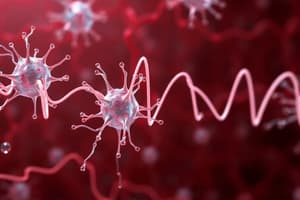Podcast
Questions and Answers
What type of channels participate in depolarization at the membrane of cardiac muscle cells?
What type of channels participate in depolarization at the membrane of cardiac muscle cells?
- Fast voltage-gated K+ channels
- Slow voltage-gated Ca2+ channels
- Voltage-gated Na+ channels (correct)
- Non-voltage gated Cl- channels
Which ion is significant in the normal function of cardiac muscle cells?
Which ion is significant in the normal function of cardiac muscle cells?
- Potassium (K+)
- Chloride (Cl-)
- Calcium (Ca2+) (correct)
- Sodium (Na+)
What happens to the membrane potential during depolarization of cardiac muscle cells?
What happens to the membrane potential during depolarization of cardiac muscle cells?
- It changes from -90 mV to +30 mV
- It remains at +30 mV
- It remains at -90 mV
- It changes from +30 mV to -90 mV (correct)
What triggers the opening of fast voltage-gated Na+ channels in the sarcolemma of cardiac muscle cells?
What triggers the opening of fast voltage-gated Na+ channels in the sarcolemma of cardiac muscle cells?
In which direction does Ca2+ move in response to the opening of voltage-gated Ca2+ channels in cardiac muscle cells?
In which direction does Ca2+ move in response to the opening of voltage-gated Ca2+ channels in cardiac muscle cells?
Which ion channel is involved in the repolarization of the membrane of cardiac muscle cells?
Which ion channel is involved in the repolarization of the membrane of cardiac muscle cells?
What is the main difference between the refractory period of skeletal and cardiac muscle cells?
What is the main difference between the refractory period of skeletal and cardiac muscle cells?
What condition is characterized by sustained muscle contraction without any relaxation?
What condition is characterized by sustained muscle contraction without any relaxation?
Why can skeletal muscle be restimulated at a frequency that does not allow for complete relaxation?
Why can skeletal muscle be restimulated at a frequency that does not allow for complete relaxation?
In skeletal muscle fibers, what occurs while sarcomeres are still contracting?
In skeletal muscle fibers, what occurs while sarcomeres are still contracting?
What event delays repolarization in cardiac muscle cells, leading to a longer refractory period?
What event delays repolarization in cardiac muscle cells, leading to a longer refractory period?
How long does it take for muscle contraction and relaxation associated with sarcomeres in cardiac muscle cells to occur?
How long does it take for muscle contraction and relaxation associated with sarcomeres in cardiac muscle cells to occur?
What are the three variables that may influence stroke volume?
What are the three variables that may influence stroke volume?
What is the typical end-diastolic volume (EDV) in a resting adult?
What is the typical end-diastolic volume (EDV) in a resting adult?
What is the typical end-systolic volume (ESV) in a resting adult?
What is the typical end-systolic volume (ESV) in a resting adult?
How is stroke volume (SV) calculated?
How is stroke volume (SV) calculated?
What is the primary mechanism by which sympathetic stimulation increases heart rate?
What is the primary mechanism by which sympathetic stimulation increases heart rate?
Which of the following factors can influence end-diastolic volume (EDV)?
Which of the following factors can influence end-diastolic volume (EDV)?
Which of the following factors can influence end-systolic volume (ESV)?
Which of the following factors can influence end-systolic volume (ESV)?
Which of the following is NOT a positive chronotropic agent mentioned in the text?
Which of the following is NOT a positive chronotropic agent mentioned in the text?
How does thyroid hormone increase heart rate?
How does thyroid hormone increase heart rate?
What is the role of protein kinase enzymes in the sympathetic regulation of heart rate?
What is the role of protein kinase enzymes in the sympathetic regulation of heart rate?
Which of the following is a direct effect of sympathetic stimulation on the AV node?
Which of the following is a direct effect of sympathetic stimulation on the AV node?
Which of the following is a mechanism by which chemical compounds can increase heart rate?
Which of the following is a mechanism by which chemical compounds can increase heart rate?
What causes the atrioventricular (AV) valves to close and the semilunar valves to open during ventricular ejection?
What causes the atrioventricular (AV) valves to close and the semilunar valves to open during ventricular ejection?
What is the end-diastolic volume?
What is the end-diastolic volume?
What is the relationship between end-diastolic volume, end-systolic volume, and stroke volume?
What is the relationship between end-diastolic volume, end-systolic volume, and stroke volume?
What is the primary function of the cardiac output?
What is the primary function of the cardiac output?
Which phase of the cardiac cycle is associated with ventricular contraction?
Which phase of the cardiac cycle is associated with ventricular contraction?
Which of the following statements about the cardiac cycle is true?
Which of the following statements about the cardiac cycle is true?
Flashcards are hidden until you start studying




